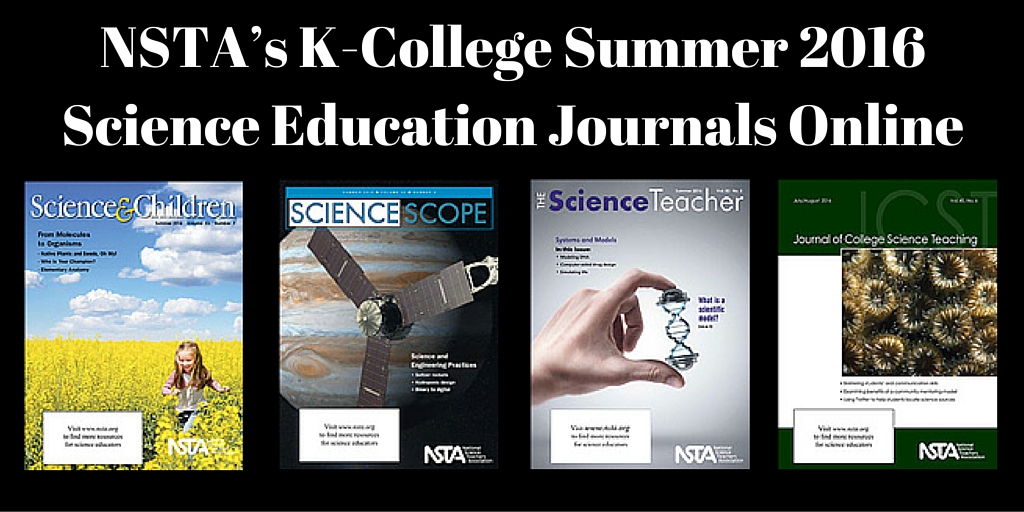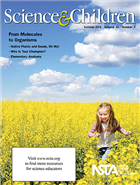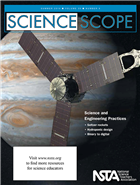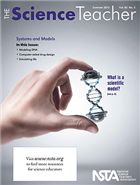NSTA’s K-College Summer 2016 Science Education Journals Online
By Korei Martin
Posted on 2016-07-01
Want to engage your students in learning about structure and processes from molecules to organisms? What about learning more about Juno’s mission to Jupiter? Are your high school students confused on what the word model means in relation to science? Are your college students interested in interdisciplinary problem based learning? The Summer K–College journals from the National Science Teachers Association (NSTA) have the answers you need. Written by science teachers for science teachers, these peer-reviewed journals are targeted to your teaching level and are packed with lesson plans, expert advice, and ideas for using whatever time/space you have available. Browse the Summer issues; they are online (see below), in members’ mailboxes, and ready to inspire teachers!
The Next Generation Science Standards call for students to learn structure and processes, from molecules to organisms. In this issue of Science and Children, students discover how plant and animal structures can solve a problem, how plant parts work together and function—and even get an introduction to parts of the human body.
Featured articles (please note, only those marked “free” are available to nonmembers without a fee):
- Elementary Anatomy
- Learning About Plants With STEAM
- Who Is Your Champion?
- Stalk It Up to Integrated Learning
- Making the Transition to Three-Dimensional Teaching
- Free – Native Plants and Seeds, Oh My!
- Free – Editor’s Note: From Molecules to Organisms
- Full Table of Contents
Juno’s mission to Jupiter is one of the latest aerospace engineering marvels that is expanding our understanding of our solar system and the universe. Help launch the next wave of engineers that will build on Juno’s success by sharing the activities found in this issue with your students.
Featured articles (please note, only those marked “free” are available to nonmembers without a fee):
- Bone Tissue Engineering: An Interactive Engineering Design Module
- Engineering Seltzer Rockets
- Engineering Technology for the Digital World
- WISEngineering Hydroponics: A Technology-Enhanced, Life Science Engineering Design Unit
- Tired and True: Falling in Style
- Free – Editor’s Roundtable: Saying Goodbye: An Editor’s “Footprint” on Science Scope
- Free – Evaluating the Egg Drop: Using the EQuIp Rubric to Ensure Activities Meet the Next Generation Science Standards
- Full Table of Contents
Fashion models, role models, economic models, model organisms, 3D models, climate models, model airplanes, model cars, and car models. We use the term model in so many ways in everyday speech, it’s no wonder students are often confused when we talk about models in science class. In every scientific discipline, the most important overall goal is to develop understanding of how the natural world works through the construction of scientific models, which are conceptual models. Our classes should be focused on engaging students in this central science and engineering practice.
Featured articles (please note, only those marked “free” are available to nonmembers without a fee):
- Computer-Aided Drug Design
- Connecting the Visible World With the Invisible
- Crafting a Masterpiece
- Explaining Ramps With Models
- Simulating Life
- Free – Editor’s Corner: What Is a Scientific Model?
- Free – Modeling DNA
- Full Table of Contents
Journal of College Science Teaching 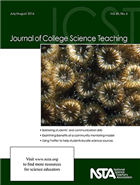
Read about an interdisciplinary, problem-based learning course titled Writing Science for the Public that was designed to teach students how to effectively communicate science to the public. Learn how a model for an optional, research-based course was
used to bridge two traditionally separate, introductory science courses. And don’t miss this issue’s Two-Year Community column, which features an article on a project that provided scholarships and an embedded social worker model to increase retention, graduation, and employment rates for at-risk students in a STEM field.
Featured articles (please note, only those marked “free” are available to nonmembers without a fee):
- What Can Students Learn About Lab Safety From Mr. Bean?
- Research and Teaching: Using Twitter in a Nonscience Major Science Class Increases Journal of College Science Teaching
- Learning Experiences of University Biology Faculty: A Qualitative Pilot Study
- Research and Teaching: The Explorations Program: Benefits of Single-Session, Research-Focused Classes for Students and Postdoctoral Instructors
- Live From Boone Lake: Interdisciplinary Problem-Based Learning Meets Public Science Writing
- Assessing Climate Literacy Content in Higher Education Science Courses: Distribution, Challenges, and Needs
- Free – A Community Mentoring Model for STEM Undergraduate Research Experiences
- Full Table of Contents
Get these journals in your mailbox as well as your inbox—become an NSTA member!
The mission of NSTA is to promote excellence and innovation in science teaching and learning for all.
Follow NSTA
Disclaimer: The views expressed in this blog post are those of the author(s) and do not necessarily reflect the official position of the National Science Teaching Association (NSTA).



